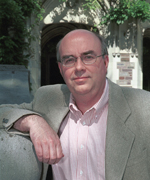Warren S. Warren | |
|---|---|
 Warren, 2002 | |
| Born | August 16, 1955 |
| Alma mater | Harvard University, AB University of California, Berkeley, PhD |
| Known for | Work in the field of Nuclear magnetic resonance and Nonlinear optics |
| Awards | William F. Meggers Award in Spectroscopy (2018) Liversidge Award (2017) C.E.K. Mees Medal (2015) Herbert P. Broida Prize (2011) |
| Scientific career | |
| Fields | Chemistry, Physics |
| Institutions | Princeton University, 1982–2005 Duke University, 2005–2011 |
| Thesis | Selectivity in Multiple Quantum Nuclear Magnetic Resonance (1980) |
| Doctoral advisor | Alexander Pines |
Warren Sloan Warren is the James B. Duke Professor of Chemistry and director of the Center for Molecular and Biomolecular Imaging [1] at Duke University. He is also a professor of physics, Radiology, and Biomedical Engineering at the same institution. Warren is a deputy editor of the open-access journal Science Advances . He has contributed to the theory of Quantum Coherence as well as nonlinear optical spectroscopy.